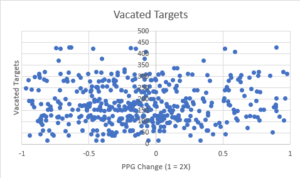Vacated Targets: What are they and why we care?
Vacated targets mean targets from the previous season that have since departed the team. For instance, Jason Witten left the Cowboys to join the Las Vegas Raiders. His 83 targets from last season in Dallas are included in the Cowboys’ 2020 vacated target total of 190. Vacated targets are commonly thrown around in the fantasy community as an indicator of “open opportunity” in an offense. In other words, vacated targets are free targets up for grabs entering the upcoming season. Dallas is second in the league in vacated targets entering 2020, behind only the Falcons (258 vacated targets).
Dallas’ vacated targets are commonly used as justification for another Gallup step, a Blake Jarwin breakout, and a fantasy relevant rookie season for 17th overall draft pick Ceedee Lamb. After all, vacated targets have to go to someone, right? And even with slight upticks to the incumbents’ respective 2019 workloads, the Cowboys still have ample vacated targets to justify breakouts for both Jarwin and Lamb, assuming the talent meets or exceeds expectations. At the very least, a rising tide should lift all boats.
Find Yards Per Fantasy On YouTube!
That’s the rationale for using vacated targets as a predictive tool for a wide receiver to receive volume in the upcoming season. And I can understand the narrative, as it makes sense conceptually. Unfortunately, statistics from the past four seasons don’t support the vacated target hypothesis. In fact, vacated targets have negligible (adj. R^2 < .01) correlation to wide receiver position group total fantasy points and fantasy point % change year over year. The same goes for individual wide receivers who stay with their team year over year, as well as wide receivers that change teams.
From this analysis, vacated targets are a red herring. Why might that be the case? Well, for starters team pass attempts are not static year over year, and neither is a player’s target share. One stark example of this is the Vikings offense from 2018 to 2019. They entered 2019 with 120 vacated targets, but passed 140 less times than in 2018. This yielded -20 real available targets, holding returning players’ prior year targets constant. Talented players earn targets. That’s not to say that more targets necessarily imply more talent – just look at Tyler Boyd vs Stefon Diggs target totals from last season. But talent is a big factor, and the better player will earn more targets, paribus ceterus.
Why Vacated Targets don’t matter
Take a look at the above graph. On the X-axis we have PPR points per game change, where 0 indicates a player’s output did not change year over year. 1 means a player’s ppg output doubled, and -1 means the player scored 0 points. On the Y axis is team vacated targets.
Included in this graph are 467 instances of players staying with their team year over year, from 2016-2019. As you can see, no relationship exists between vacated targets and ppg growth. We actually have more instances of players posting negative ppg growth seasons than positive ppg growth when we hold vacated targets to greater than 400. In fact, there are 92 instances of players posting ppg growth greater than 100-percent (removed from above graph for visual purposes), and none of those occurred on a team with greater than 350 vacated targets. Additionally, the regression yields the similar results if we use target growth instead of ppg growth, so neither targets nor fantasy production can be meaningfully explained by vacated targets.
WRs Changing Teams
Shifting to wide receivers that changed teams, I found 163 examples from the aforementioned dataset. Just like receivers that stayed with their team, vacated targets had negligible correlation to ppg growth. However, the median ppg growth for receivers changing teams was -.019, meaning they scored 98.1-percent of their previous season’s ppg. That’s a good bit higher than receivers staying with their team, who had a median ppg growth of -.039, or 96.1-percent of their previous season ppg. This tidbit is independent of vacated targets, but may offer some insights on why people think vacated targets are meaningful.
When a team brings in a new receiver, it’s often to replace a departure. A team also typically has a role in mind for a new signing, offering some floor for usage. Fantasy owners tend to only check vacated targets when anticipating an incoming player’s potential role. So in reality, they would be conflating the overperformance of 1st year receivers vs incumbent receivers with vacated targets, since teams with new receivers tend to have more departures and thus more vacated targets. Regardless, the main takeaway here is that whether or not your changing team is irrelevant – vacated targets don’t matter.
Before I totally conclude that vacated targets mean nothing for next season’s fantasy performance, let’s add a couple caveats:
- The dataset is noisy: Injuries, quarterback changes, scheme changes, and much more are all influencing ppg change year over year
- However, even setting the target threshold at 64 (4/g), we still have negligible correlation between vacated targets and ppg growth (R^2 < .01, P value = .24)
- The dataset is limited: we have plenty of datapoints from the past four seasons, but we don’t know if those four seasons on the whole are an outlier from the broader population of all NFL seasons
Conclusion
Vacated targets should not factor into your fantasy decisions one way or the other. Vacated targets tell us more about an offense’s churn in general than it does about the opportunity available to a certain player in that offense. At least over the past four seasons, vacated targets have offered no insights into how a player will perform, so using this metric to predict 2020 performance is not advisable – especially with the extra uncertainty added by Covid-19.
So, what should you do with this information? Go rave to all your leaguemates about how Atlanta’s 258 vacated targets means Hayden Hurst will have ample opportunity this season, and promptly sell him for an overpay. Or go the other route and buy Stefon Diggs on the notion that Buffalo’s league-low 35 vacated targets means Diggs won’t get much chance to prove himself this season. Either way, fade the vacated targets narrative to your advantage!







